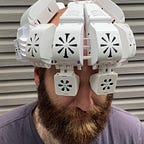Improve your Design Sprint with Behavioral Assessments
Don’t let behavioral styles get in the way!
Today, Design Sprints are synonymous with innovation. However, there are plenty of examples of when a project leans more towards design over user experience.
Why does this happen?
Many design teams are set-up with noble intentions. Unfortunately, there are times when a design team isn’t filled with the right balance of behavioral styles. Our behavorial tendancies make up a large portion of what we bring to our work everyday. However, often it’s not discussed when a group of people are trying to make agree on a decision or strategy.
As an example, during a past design sprint, did your idea generation phase move more into realistic ideas rather than true brainstorming? Did this hinder the depth of ideas? Or, perhaps the opposite happened during the design phase; did your team keep coming up with more ideas than you had during the ideation phase?
Project teams often understand their shared goal. However, our individual behavorial prefences can get in the way.
What fuels our behaviors?
Humans are complex. However, we are also predictable.
Personality and behavorial testing has existed since at least the 1950s and it has shown that we can reliably discover patterns in our own behaviors. As an example, let’s think about why certain people are more dynamic than others.
Below is a continuum with two opposite behaviors: Boldness and Cautiousness
Anyone can be either bold or cautious. However, we will often lean towards using one behavior over the other.
Think back to a meeting you had. As a topic is being discussed, do you express your opinions openly and honestly? Or, do you hold back and wait until you are sure it’s the right time; even if that means you might not actually express your opinion.
Behavioral assessments look to identify a multitude of behaviors to determine a person’s Personality Style. This style can mean different things depending on the assessment that you use.
Many of these tools require a self-assessment. While this process is extremely simple on the surface, it can provide a wide window into learning more about how we make decisions, communicate, or even listen. The complexity of the assessment can range from being a simple 26 question DISC assessment to a 45 minute Gallup Strength Finder assessment. Each assessment is looking to measure different aspects of a person’s behavior.
One particular assessment can be really useful in supporting the design process. The Team Dimensions 2.0 assessment is used by many financial firms because of how it can help teams move a idea from creation to execution in a simple process that leans on have the right person contribute at a specific time.
Team Dimensions 2.0 — Discover your work style
The Team Dimensions profile provides a person with both their behavorial style and then a process that they can use when working in a group. The tool assigns a person with one of the following styles:
- Creator: This style features individuals who live to create fresh ideas and is always looking for new perspectives. They can’t stop coming up with new ideas.
- Advancer: A person with this style is an early adoptor of new ideas. While they might not be as creative as a Creator, they will take on new ideas and promote the hell out of them.
- Refiner: This style isn’t as quick to adopt a new idea. However, they are able to look at new ideas and determine ways to make them more stable.
- Executor: This style is the furthest from the creativity spectrum. They would prefer to take developed ideas and strategies and just implement them to find out the results.
- Flexor: A Flexor is a person who can move easily between any style.
Each style helps a person understand their role when working on a project team by outlining a process called the Z Process.
The process assigns a certain person to work on a specific part of a project based on their work style. It aligns our strengths with what we want to work on.
Groups that follow this process will place people on parts of a project based on their specific work style. To help improve a design sprint, groups can use this profile and adapt the Z-process to help place the right person during a specific day. Here’s how it could work:
- Day 1: (Map) Creators and Advancers
- Day 2: (Sketch) Creators, Advancers and Refiners
- Day 3: (Decide) Advancers and Refiners
- Day 4: (Prototype) Advancers, Refiners, and Executors
- Day 5: (Test) Everyone
The results from this process can be astounding. Individuals have more energy because they are working on the parts of the project they enjoy without being held back. Projects are completed more quickly and solutions become more effective.
Does your team use behavioral assessments when developing your team? I would love to hear what you have to found to promote successful projects.
